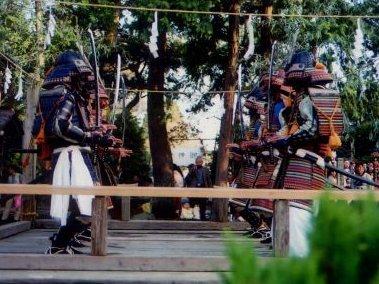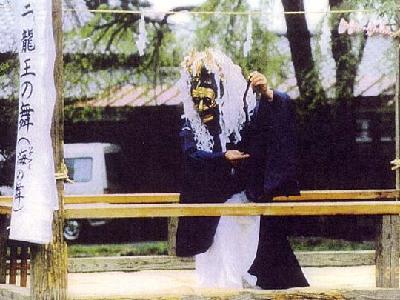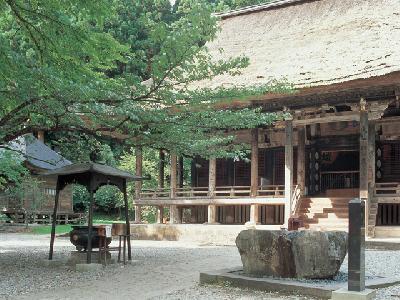|
Kumanodo Bugaku is a folk performing art performed at the annual spring festival of Kumano Shrine in Takadate Kumanodo, Natori city, Yamagata Prefecture. Bugaku is a repertoire of dances of the Japanese Imperial court, derived from traditional dance forms imported from China, Korea, and India.
It is said that the Bugaku dance was introduced to the Kumanodo area by the Hayashi family in Risshakuji Temple in Yamadera, Yamagata City, Yamagata Prefecture, but there is no precise records concerning its origin. The Hayashi family was the hereditary musician family serving the Japanese Imperial Court. As the Hayashi family moved to present Yamagata Prefecture before Bugaku was japanized in the mid-Heian period, the old dancing style of the imported dance has been precisely handed down in the Kumanodo Bugaku dance. It is designated as a prefecture’s folk cultural property.
In the Kumanodo Bugaku dance, neither dialog nor words are employed in the dances and songs. It is a kind of pantomime in dedication to the god. Although it has an origin in the Shinto dance, it also has several features of the dances performed by Shugendo practitioners.
The 3.6 m square temporary stage is built over the pond in the precinct. In back of the stage, the ensemble composed of one drum, one pair of large clappers and one Japanese flute play the music.
It is said that the Bugaku dance was introduced to the Kumanodo area by the Hayashi family in Risshakuji Temple in Yamadera, Yamagata City, Yamagata Prefecture, but there is no precise records concerning its origin. The Hayashi family was the hereditary musician family serving the Japanese Imperial Court. As the Hayashi family moved to present Yamagata Prefecture before Bugaku was japanized in the mid-Heian period, the old dancing style of the imported dance has been precisely handed down in the Kumanodo Bugaku dance. It is designated as a prefecture’s folk cultural property.
In the Kumanodo Bugaku dance, neither dialog nor words are employed in the dances and songs. It is a kind of pantomime in dedication to the god. Although it has an origin in the Shinto dance, it also has several features of the dances performed by Shugendo practitioners.
The 3.6 m square temporary stage is built over the pond in the precinct. In back of the stage, the ensemble composed of one drum, one pair of large clappers and one Japanese flute play the music.
| [+ADDRESS] | 
|














